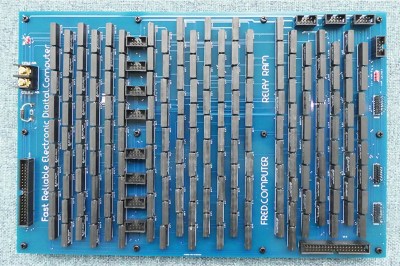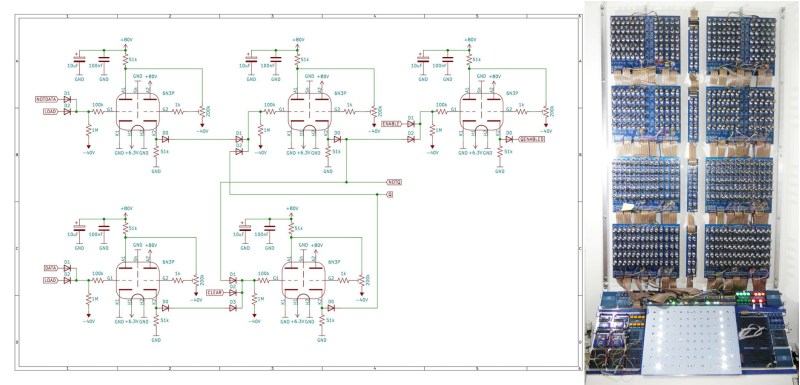It doesn’t happen often that we report on new vacuum tube based computer designs. Today however, we’re pleased to introduce to you the Fast Reliable Electronic Digital Dot Computer, or Fred.Computer for short. It’s the brainchild of [Mike] who also brought us ENA, which we featured earlier.
Fred is a new design that reuses the parts that made up ENA. It has an 8-bit CPU, 16 bytes of RAM, 256 bytes of NVRAM, and runs at a clock speed of 11.3 kHz. With its 560 tubes drawing a total supply current of about 200 A it also provides a fair bit of heating to [Mike]’s study. The main logic is implemented through NOR gates, built from 6N3P dual-triode tubes sourced from Eastern Europe. These NOR gates are combined into more complex structures like latches, registers and even a complete ALU. A total of sixteen machine code instructions can be used to write programs; clever design allows Fred to perform 16, 32 or even 64-bit calculations with its 8-bit ALU.

An interesting addition is a new RAM design based on reed relays. [Mike] realised that relays are actually very similar to digital transmission gates and can therefore be used to make a simple static RAM cell. If you thought relays were too slow for RAM cells, think again: these reed relays can toggle at a mind-boggling 700 Hz, making them more than fast enough for Fred.
The main I/O device is a console that contains several pushbuttons as well as a 12 x 8 LED display. All of this makes Fred a fully-functional general-purpose computer that’s even capable of playing Pong (video, embedded below). [Mike]’s website is full of interesting detail on all aspects of vacuum tube computer design, and makes delightful reading for anyone tempted by the idea of building their own.
Can’t get enough of vacuum tube computers? Have a look at this 1-bit MC14500 implementation, marvel at this modern interpretation of an adding machine, or find out how IBM designed its logic in the 1950s.
















My 1954 tube computer
https://photos.app.goo.gl/hxyKEUC2fNUB2jDK9
You made that by yourself?
You made that yourself?
It would have been interesting to use those glass piezoelectric delay lines often found in old TVs and VCRs to store a scan line. They still feel a bit like magic, even after understanding the physics.
I’d like to see a hollow state computing era correct rotating drum capacitive memory using a flexible PCB with SMD capacitors wrapped around a drum; a regenerative capacitor memory using modern components with more storage and greater speed than this:
“The first regenerative capacitor memory built was the rotating capacitor drum memory of the Atanasoff–Berry Computer (1942). Each of its two drums stored thirty 50-bit binary numbers (1500 bits each), rotated at 60 rpm and was regenerated every rotation (1 Hz refresh rate).”
https://www.youtube.com/watch?v=bsk4WWtRx6M
I’ve ordered 5 from the other side of the planet. Hopefully they will be here in a week or two. I will have to build an analogue test circuit to characterise them as I can’t find spec sheets but that’s ok as it will be breadboard and reusable for the proof of concept.
The original idea was to use two to make a 2-bit serial computer but I might buy another 5 if there’s any left and go all out for an 8-bit.
It will be some time before it’s done. I haven’t ordered the op-amps and other analogue components yet but there a lot easier to get.
Not meaning to slam this impressive machine, but the 1-bit MC14500 implementation doesn’t “cheat” by using semiconductor diodes in the logic. Also, electroluminescent display tubes are used for data display, not LEDs. Memory is also being implemented using tubes, not reed relays. Finally, only 24VDC is used whereas this one uses 80VDC and -40VDC.
The weird voltages that usagi uses are not necessarily an advantage. With only 24V high(ish) speed things will not be possible.
The +80 -40 approach would also make it possible to use neon’s for state indication.
From a puristic standpoint diodes are not the nicest thing to have in a tube computer, but remember that diodes where available long before transistors. The IBM 700 series (1951) used diodes.
And while also not puristic, reed relay memory is actually kind of a smart move, fast small and inexpensive.
Actually if you follow Usagi Electric closely he does use semicon diodes in the logic gates.
Tubeway army replicas we are glass
Tubeway army replicas we are glass gary numamn